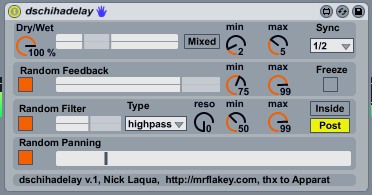
Since the release of Ableton Live 8, there has been quite a buzz around Max4Live, the common project of Ableton and Cycling’74. By integrating the powerful Max/MSP/Jitter platform, the promise was to actually enable the users to extend Live with MIDI and audio effects, virtual instruments, customized control surfaces, video playback devices………..
After a rather long beta phase, it has finally surfaced on 23rd november, and it seems to be a pretty good job. Particularly pleasing for owners of the “new kids on the block” in the Live controller world Launch Pad and APC 40 who are just waiting to put those user modes to work.
In order for my beloved monome 64 not to be left behind, I made a set of devices which will allow you to make the little 8×8 controller your one-stop shop for controlling Live.
MonoLive consists of four devices:
- MonoInterface is the central hub communicating with the controller and the other devices
- MonoMidi allows you to control a Live MIDI track (clip launch, solo/mute, EQ settings), including MIDI Editing for drum sequencing, patterns and arpeggios with up to 64 steps
- MonoAudio puts you in control of a Live Audio track (clip launch, solo/mute, EQ settings) as well as controlling the loop length a la Traktor.
- MonoBufferShuffler is based on the factory BufferShuffler device but has been enhanced to allow controlling it via the monome. The standard functionalities such as clip launch.
In addition to those features, MonoLive can do a little bit more:
- Support of up to 5 return tracks for bus effects
- Support of up to 7 FX tracks for modulation of the audio stream
- Transposition up/down
- Smooth transition of send values and EQ settings over time.
- Clip overview mode to support up to 49 tracks with 64 scenes
- MIDI overview mode to support MIDI clips over 4 octaves and 64 steps
- Optional Tempo tilt
- MIDI humanisation mode
The documentation is included with the devices, just download below and start pushing some buttons. I also provided a demo LivePack based on the free Swayzak LivePack available on the Ableton site.
Have fun and let me know how it goes…..
Download
MonoLive v0.91 (update without using 3rd party externals)
MonoLive Demo LivePack
 Probably the last update for 2009, after some sleep and feedback as well, there is a new version of dschihadelay.
Probably the last update for 2009, after some sleep and feedback as well, there is a new version of dschihadelay.


